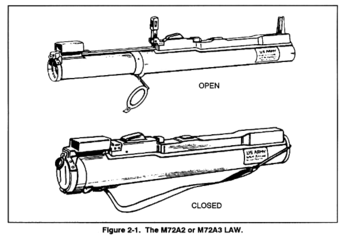M72 (weapon)
| M72 | |
|---|---|

|
|
| general information | |
| Military designation: | LAW M72 Light Antitank Weapon |
| Country of operation: | Australia, Belgium, Denmark, Great Britain, Israel, Canada, Netherlands, Norway, Austria, Luxembourg, Turkey |
| Developer / Manufacturer: | Hesse Eastern Co. Talley Industries |
| Manufacturer country: | United States |
| Production time: | 1963 to 1983 (USA), license production in Norway continuously |
| Model variants: | M72 A1, A4, A5, A6 License production: Norway: M72 A2, M72 A3 Raufoss Arsenal, Raufoss |
| Weapon Category: | Grenade weapon |
| Furnishing | |
| Overall length: |
(Transport): 655 mm (ready to fire): 893 mm |
| Weight: (unloaded) |
(Launch tube): 1.36 kg (grenade): 1.00 kg (total): 2.36 kg |
| Barrel length : | 655 mm |
| Technical specifications | |
| Caliber : | 66 mm |
| Ammunition supply : | Gun is delivered loaded |
| Cadence : | - rounds / min |
| Fire types: | single use |
| Number of trains : | Firing pin |
| Visor : | Frame sight and rear sight, 50–350 m, 25 m steps |
| Lists on the subject | |
The M72 LAW ( L ight A nti-tank W eapon , also referred to as L ight A nti-armor W eapon or LAW) is a portable, recoilless anti-tank weapon with a caliber of 66 mm. The single-use weapon was developed in the USA by Frank Spinale et al. designed in collaboration with the Hesse-Eastern Division of Norris Thermadore and is still produced today by Nammo Raufoss AS in Norway .
After the Korean War , the LAW replaced the bazooka as the primary anti-tank weapon in the US Army . The successor was the heavier AT-4 weapon .
The advantage of the M72 lies in its compact design and low weight. In addition, the instructions are shown as a sequence of images on the weapon. Before firing, you have to pull the weapon - which consists of two individual tubes - apart, and the visor also unfolds. During transport, the grenade is protected in the barrel by a cover at the front and rear that closes it watertight. When fired, there is no recoil, but a long jet flame - the so-called back beam - can arise, which is why the weapon should not be used in closed rooms. The frame sight has a scale to determine lead values for moving targets.
The M72 is fired at the push of a button. This button, about 8 cm long, is located on the top under a rubber protection and triggers a simple striking mechanism that ignites a detonator screwed in the rear of the weapon. This is connected to the grenade via a thin tube and transmits the ignition impulse like a fuse. After ignition, the 508 mm long grenade is propelled by a reactive powder propellant. A six-part stabilizer ensures that the trajectory is maintained. The grenade is armed after about 10 m flight. The grenade has an impact fuse and a HEAT warhead.
The operational range for moving targets is 150 m, for stationary targets 300 m. Buildings can be fought effectively up to a distance of 1000 m.
The penetration force in armored steel is 300 millimeters for the M72 A2 and M72 A3, M72 A4: 355 millimeters, M72 A5: 330 millimeters, M72 A6: 150 millimeters RHA . In the various versions, apart from the warheads, the rocket motors and the sighting device have also been improved.
The M190 LAW is a practice version of the M72. An M73 sub-caliber training grenade is fired from the M72 LAW launch tubes that have already been used . This has similar flight characteristics as the other sharp grenades used. The warhead, however, has an explosive charge of less than 2 g and is therefore only used to mark hits. However, the grenade should be able to penetrate wood up to 200 mm thick.
Comparable systems
literature
- Günter Wollert, Reiner Lidschun, Wilfried Copenhagen : small arms . (1945-1985). In: Illustrated encyclopedia of rifles from around the world . 5th edition. tape 1 + 2 . Brandenburgisches Verlagshaus, Berlin 1988, ISBN 3-89488-057-0 , weapons, p. 333, 473 .
